On Thursday January 26th, the Krannert Art Museum (KAM) held their opening reception for their 2017 spring semester exhibitions. While meandering through the galleries prior to public opening reception, I had the chance to view and reflect on the new temporary exhibitions. This semester KAM brings a number of thoughts and issues to the forefront in order to engage students with current events and topics through art.
Well-attended by members, faculty, and students, the reception easily had over sixty people there to hear Director Kathleen Harleman’s welcome speech. Harleman introduced each exhibit with ease and highlighted curators Amy L. Powell and Kathryn Koca Polite for their hard work. She also acknowledged the work of graduate students and Professor Terri Weissman in the creation of their exhibition. Harleman kept her speech short and sweet due in part to a temperamental microphone. After the applause had died down, the gathered crowd in the Rose Nelvin Gallery dispersed to explore the museum.
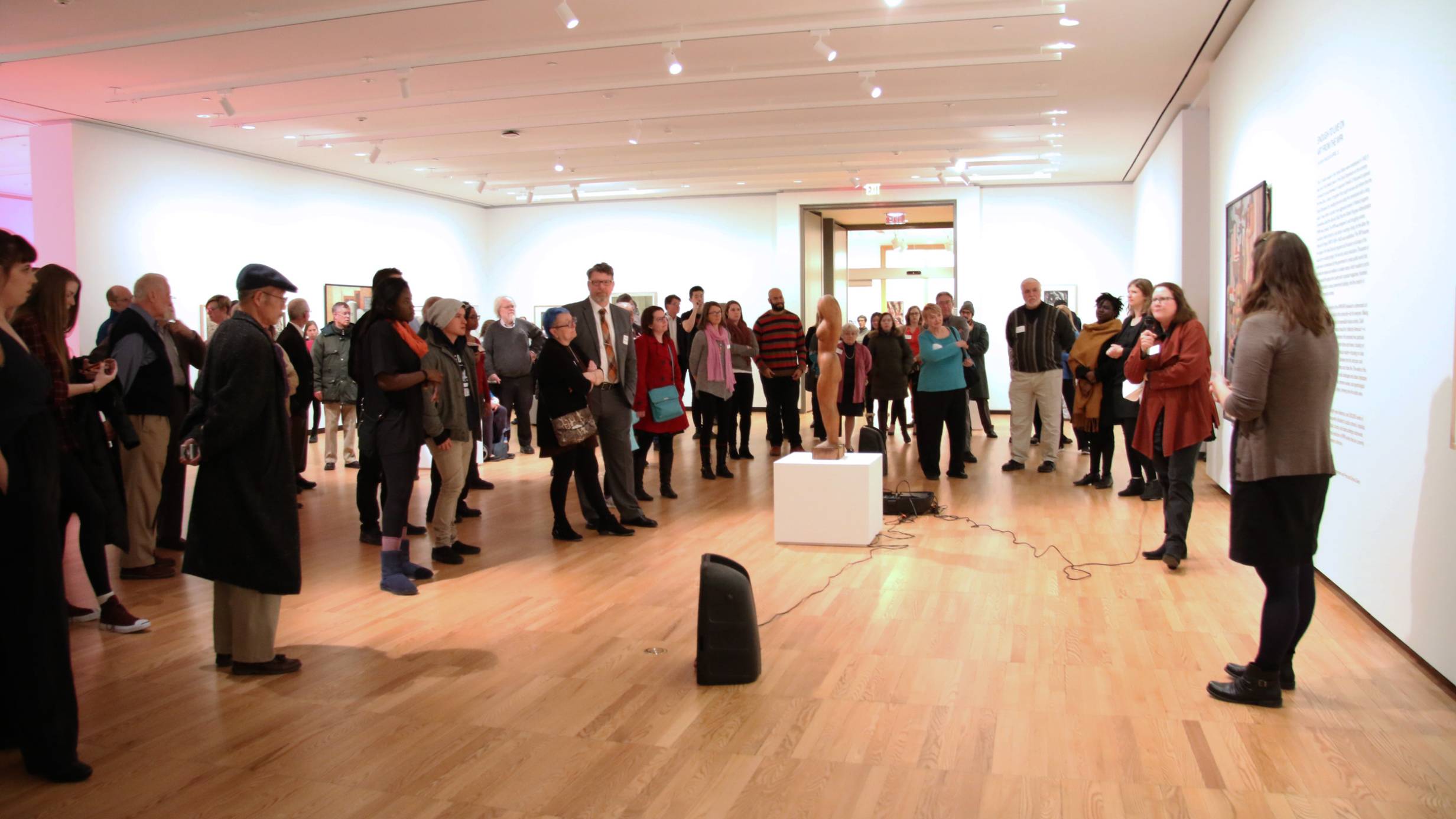
Currently, KAM has a lot to offer visitors. There are four temporary exhibitions alongside Zina Saro-Wiwa: Did You Know We Taught Them How To Dance? (closes Saturday March 25th) and Making and Breaking Medieval Manuscripts (closes February 11th). They are: Enough to Live On: Art of the WPA, Land Grant, Autumn Knight: In Rehearsal, and Light and Movement in Sculpture. Each of these exhibitions highlight an aspect of the museum’s mission as well as the diversity of art in its collection. I’ll do my best to give a brief explanation and impression of each exhibition.
Enough to Live On: Art of the WPA occupies the majority of the Rose Nelvin Gallery and covers a very familiar period of art history. The WPA, or Works Progress Administration, was one of Franklin D. Roosevelt’s New Deal relief programs. The government program hired hundreds if not thousands of artists— playwrights, painters, sculptors, actors, writers, etc.— and gave them work. The work then gave them money to live on (hence the name of the exhibition). What this meant for communities was murals in public buildings, prints and watercolors in classrooms, and sculptures dotting public spaces. Curated by Kathryn Koca Polite, Enough to Live On highlights 45 of the 546 works allocated by the government to the care of the KAM after the New Deal ended.
Polite deftly groups the works into common themes: artists pushing against the WPA’s preferred American regionalist style (think Stuart Davis or Salvador Dali instead of Grant Wood and Thomas Hart Benton), the industriousness of rural and urban Americans, industrial cityscapes, and nightlife. For example, Hugh Pearce Botts’ Nana (ca. 1938; etching and aquatint) of an older woman ironing a dress shirt in her kitchen is side by side with Margette Oatway Dornbusch’s Wheat (ca. 1934; lithograph), which shows a farmer with his scythe taking a break from reaping and harvesting. It’s a nice pairing of man and woman, young and old, different styles, and different kinds of industriousness. While Edwin Boyd Johnson’s Mural Painting (1934; oil on canvas) is the standout piece with local ties and recent conservation, I found myself drawn to the smaller (and satirical) prints in the exhibition. For instance, Fritz Eichenberg’s Preaching to the Fishes (ca. 1936-1942; wood engraving) is a small, humorous piece of an evangelist with his Bible in a diving suit preaching to a gathering of deep sea creatures. There are other gems in the exhibition that I encourage visitors to seek out when they spend some time in Enough to Live On.
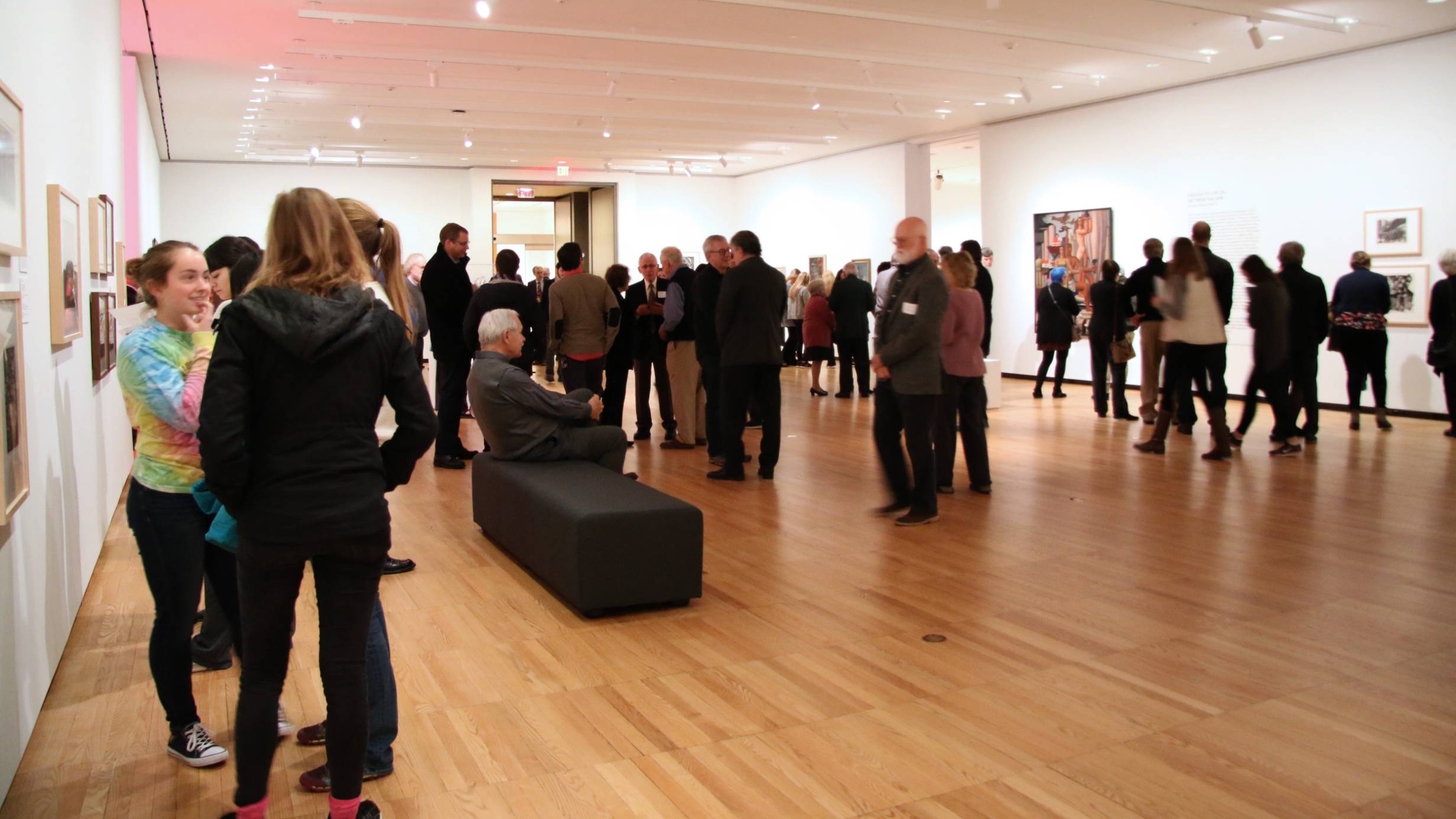
Land Grant is collaborative exhibition with a large theme, plentiful subtopics, and a lot of thoughts. The exhibition is the result of ARTH546, a graduate student-level practicum in curatorial methods taught by KAM curator Polite and Professor Terri Weissman. The students who took the course were: Alyssa Bralower, Yue Dai, Evin Dubois, Maria Garth, Michael Hurley, Cory Imig, Lilah Leopold, Jenny Peruski, Luis Gonzalo Pinilla, and Allison Rowe. Using objects and images to “both legitimize and contest power,” Land Grant explores the status of higher-level public education in the United States. In particular the exhibition focuses on the Illinois’ Sesquicentennial as its overarching theme. The sub-themes or questions seemed to be: how did the University look at itself upon its foundation compared to today? What objects and images along with stories, discussions, and questions can be explored and shared? What current events and issues can be linked to the past? For example, a documentary clip of wheelchair basketball in its early days is used to highlight the founding of Illinois’ Disability Resources and Education Services (DRES).
At a glance, Land Grant is a hodge podge of objects, but it is a demanding exhibition. Objects in Land Grant range from photographs and campus zines to Morrow Plots soil samples and the corn canoe made of concrete from the College of Engineering. Sometimes the objects have obvious connections while others seem to have tenuous relationships with the thoughts presented in the label. The curation team pulled objects from the KAM, Rare Books and Manuscripts Library, University Archives, the Illinois History and Lincoln Collections, Ricker Library of Architecture and Art, the Geological Samples Library, the President’s Office, the College of Engineering, and the Champaign County Historical Archives at The Urbana Free Library. Due to the gallery space being incredibly popular during the opening reception, I found it hard to get the gist of the ideas from simply looking or skimming a label. I ended up leaving the gallery having more questions about the design of the exhibition than questions about the thoughts presented by the exhibition.
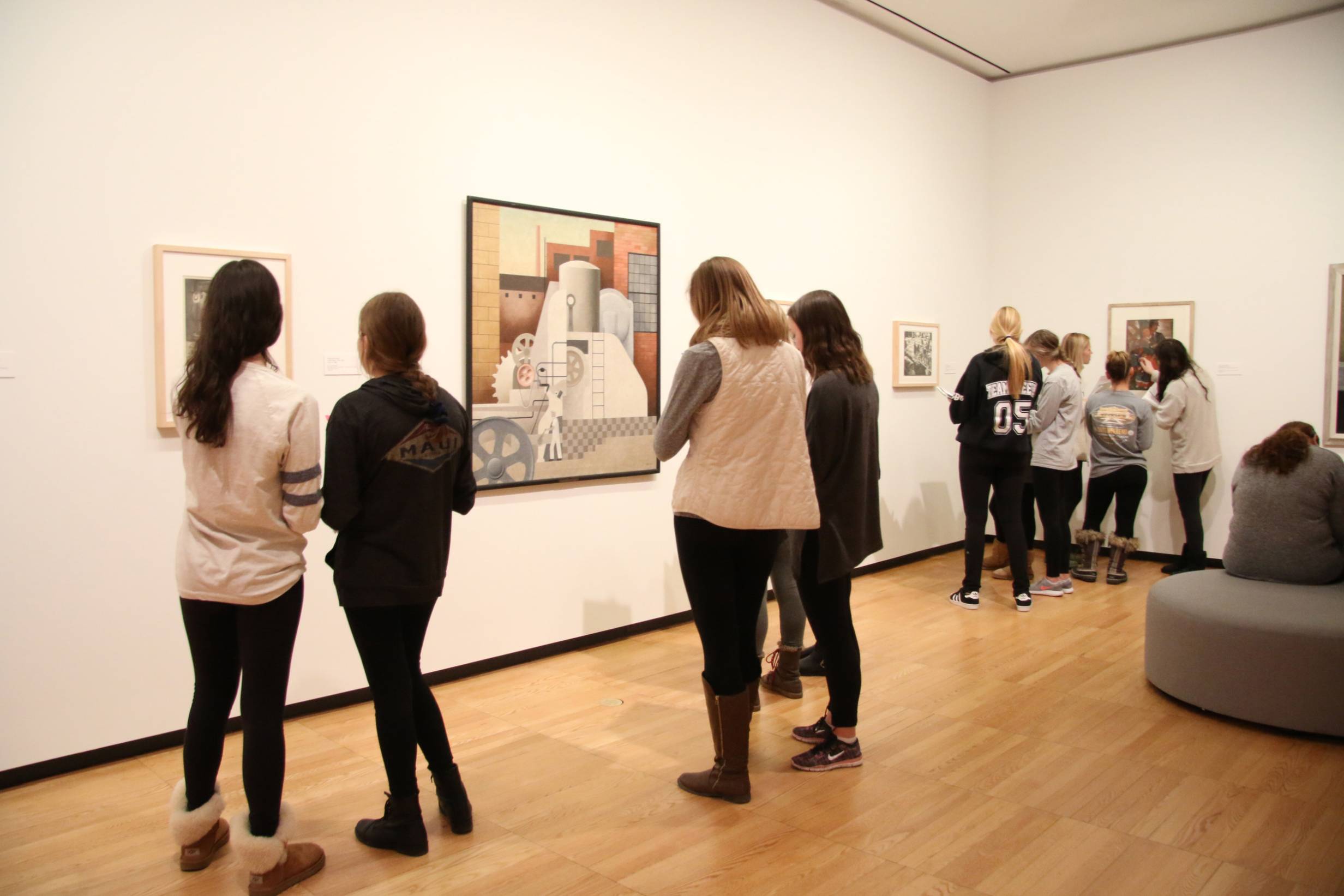
Eventually, I meandered my way to the Kinkaid Gallery to see Light and Movement in Sculpture. Co-curated with assistance from Art History doctoral candidate Hayan Kim, curator Amy L. Powell highlights artists who experimented with light and movement in the mid-twentieth century. There are only seven artworks in the exhibition, which feels perfect for this transitional space. Chryssa’s Automat (1970; neon and plexiglass) is an eye-catching work about reflection, illumination, advertisement, design, wordplay, and a bygone era of urban life lit by neon signs in windows. Josef Levi’s Vinum 8 (1966; liquitex, perforated metal, and fluorescent light) seemed to garner the most attention from the few visitors in the gallery. One girl called it “cool” as she moved from side to side to see how the light shifted and changed based on her perspective.
Autumn Knight: In Rehearsal highlights the artist in residence for the semester at KAM. Autumn Knight, originally from Houston but now based in Harlem, combines various fields of study in order to create engaging performances on gender, race, and authority. If all of her performances are like El Diablo y Cristo Negro, they are also infused with an abundance of pop culture nods and references. The performance took place in the transformed Gelvin Noel Annex, a white box thanks to painted walls and white mortar board on the floor. Props like a movable wall, scaffold, and ladder were at the ready. Before the performance video projects played various clips, some manipulated and some not, of a singer, people dancing, muppets, and commercial snippets. A roll of green bubble wrap stretched down the middle of the annex (and became the highlight for the younger audience pre-performance). However, the space changed with the start of the performance. Chivas Michael, a New Orleans-based actor, and Xavier Roe, an Illinois Theatre student, entered as the Devil and Black Christ respectively. Bedecked in silver sparkles from head to toe and a pair of shades, Black Christ asks the Devil, clad in black ripped tights, a tutu, and fabulous hair, for some sugar. Their conversation then zipped up, down, and all around. “The electoral college was my idea,” zings the Devil with a hair flick. However, Black Christ refuses to be drawn into a philosophical discussion about their existence and meaning. Eventually, the Devil caves and gives the Black Christ some sugar to finish making his Funfetti birthday cake. This scene was only the first in a dynamic, engaging, and thought-provoking performance piece. My words don’t seem to capture the quick wit of Knight’s dialogue and its delivery or the humor in the acting choices made by Michael, Roe, and Knight. If all of Knight’s performance pieces are like El Diablo y Cristo Negro, count me in.
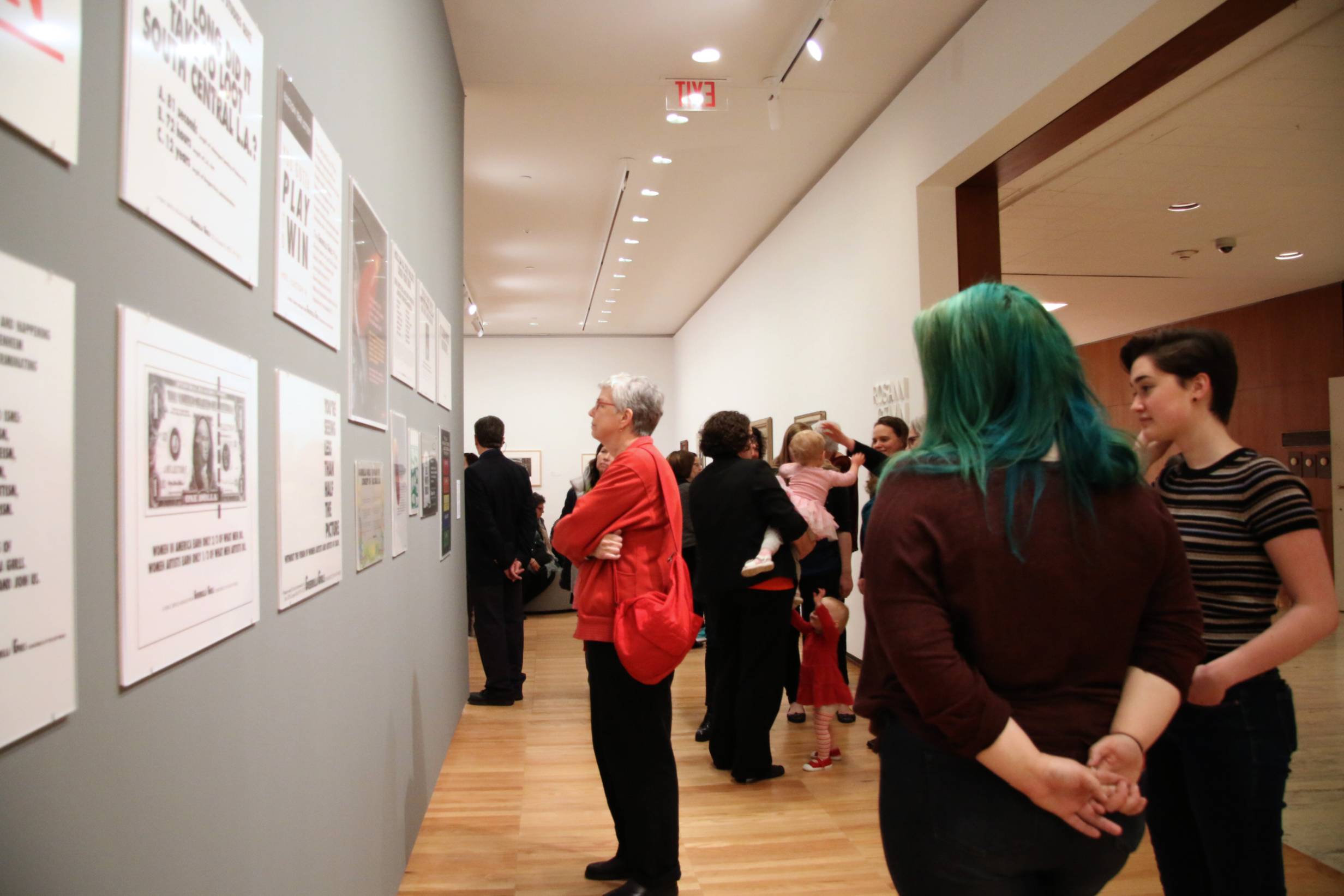
All in all, KAM’s spring 2017 season covers a great deal. From thought-provoking exhibitions to engaging performance pieces, KAM has something for every art lover this semester. In order to make visiting easier, here is a list of all of the exhibitions currently on view and when they end:
- Making and Breaking Medieval Manuscripts ends on Saturday February 11th.
- Zina Saro-Wiwa: Did You Know We Taught Them How to Dance? ends on Saturday March 25th.
- Enough to Live On: Art of the WPA will be on view until Saturday April 22nd.
- Autumn Knight: In Rehearsal will be on view until Saturday May 13th. Knight is the artist in residence this semester so be on the look out for her forthcoming performance pieces or check out the exhibition library guide to learn more about her work.
- Light and Movement in Sculpture will be on view until Sunday May 14th.
- Land Grant will be on view until Saturday July 8th.
For more information, visit KAM’s website for all dates, times, and locations.
Photos by Julia Nucci Kelly, 2017. Courtesy Krannert Art Museum.
Sarah Keim is a contributing writer for Smile Politely’s Arts section. She’s a bit of recluse on social media, but you might bump into her out in the wilds of C-U. Frequent sightings occur at coffee shops, movie theaters, and used record stores.








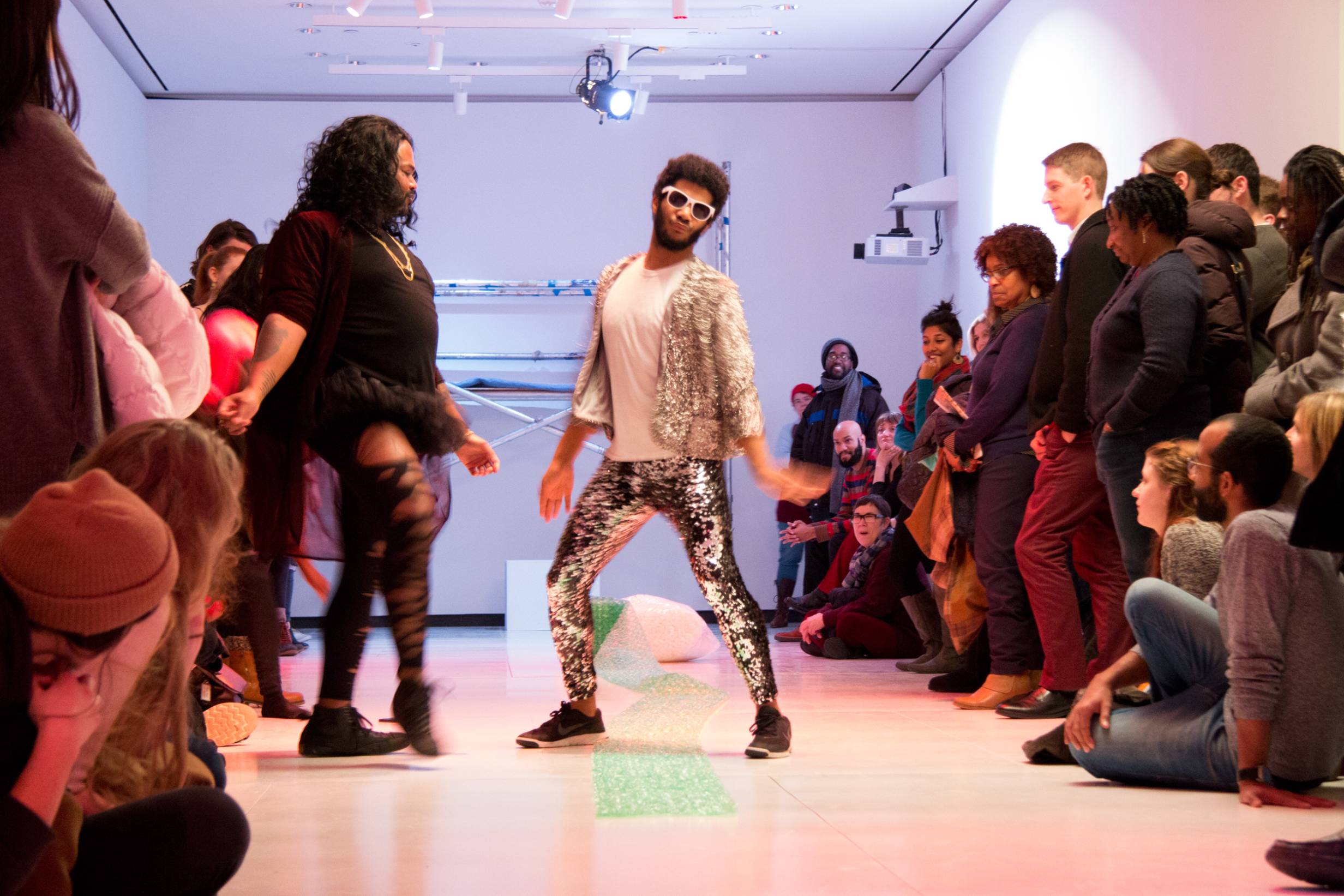
 Sarah Keim is a contributing writer for Smile Politely’s Arts section. She’s a bit of recluse on social media, but you might bump into her out in the wilds of C-U. Frequent sightings occur at coffee shops, movie theaters, and used record stores.
Sarah Keim is a contributing writer for Smile Politely’s Arts section. She’s a bit of recluse on social media, but you might bump into her out in the wilds of C-U. Frequent sightings occur at coffee shops, movie theaters, and used record stores.